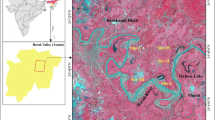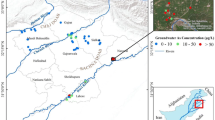Abstract
Arsenic (As) concentrations in fine (2) and coarse (3) rice varieties belonging to Hafizabad, Gujranwala and Sheikhupura districts was assessed initially by means of field survey, followed by pot experiments. Bulk soil samples collected from same rice districts (Hafizabad and Gujtanwala) were spiked with As (0, 10, 20 mg kg−1) and each was amended with iron sulphate (0, 25, 50 g kg−1) to investigate their effect on plant growth and uptake under anaerobic conditions. Survey results revealed that mainly fine long grain (Super Basmati and KSK 515) and coarse long grain (Basmati 386 and Kainat) rice varieties were grown in the area. Overall, 16% rice grain samples were above the recommended permissible limit (RPL) of 300 mg kg−1. Among varieties, 24% grain samples of coarse and 12% of fine varieties had As concentration above the RPL. Results of pot experiments showed a significant decrease in straw and grain yield and increase in As concentration with increasing rates of As spiking. Paddy yield increased significantly when As spiked soils were amended with iron sulfate; and opposite was true for As concentration.


Similar content being viewed by others
References
Aide M, Beighley D, Dunn D (2016) Arsenic in the soil environment: a soil chemistry review. Int J Appl Agric Res 1:1–28
Ascar L, Ahumada I, Richter P (2008) Influence of redox potential (Eh) on the availability of arsenic species in soils and soils amended with biosolid. Chemosphere 72:1548–1552
Bhattacharya P, Samal AC, Majumdar J, Santra SC (2009) Transfer of arsenic from groundwater and paddy soil to rice plant (Oryza sativa L.): a micro level study in West Bengal, India. World J Agric Sci 5:42–431
Bhattacharya P, Samal AC, Majumdar J, Santra SC (2010a) Arsenic contamination in rice, wheat, pulses, and vegetables: a study in an arsenic affected area of West Bengal, India. Water Air Soil Pollut 213:3–13
Bhattacharya P, Samal AC, Majumdar J, Santra SC (2010b) Uptake of arsenic in rice plant varieties cultivated with arsenic rich groundwater. Environ Asia 3:34–37
FAO/WHO (2018) Codex Alimentarius Commission. Joint FAO/WHO Food Standards Program ‘Codex Committee on Contaminants in Foods’ (CF/8 INF/1). Utrecht, The Netherlands, 12–16 March 2018
Farooqi A, Masuda H, Firdous N (2007) Toxic fluoride and arsenic contaminated groundwater in the Lahore and Kasur districts, Punjab, Pakistan and possible contaminant sources. Environ Pollut 145:839–849
Hossain MF (2006) Arsenic contamination in Bangladesh—An overview. Agr Ecosyst Environ 113:1–16
Lee CH, Wu CH, Syu CH, Jiang PY, Huang CC, Lee DY (2016) Effects of phosphorous application on arsenic toxicity to and uptake by rice seedlings in As-contaminated paddy soils. Geoderma 270:60–67
Ma JF, Yamaji N (2006) Silicon uptake and accumulation in higher plants. Trends Plant Sci 11:392–397
Meharg AA (2004) Arsenic in rice – understanding a new disaster for South-East Asia. Trends Plant Sci 9:215–217
Miretzky P, Cirelli AF (2010) Remediation of arsenic-contaminated soils by iron amendments: a review. Crit Rev Environ Sci Technol 40:93–115
Mushtaq A (1986) Proceedings of XII international forum on soil taxonomy and agrotechnology transfer, 9–23 October 1985, Lahore, Pakistan. Soil Survey of Pakistan, Lahore, Pakistan
Nath S, Panda P, Mishra S, Dey M, Choudhury S, Sahoo L, Panda SK (2014) Arsenic stress in rice: redox consequences and regulation by iron. Plant Physiol Biochem 80:203–210
Norton GJ, Adomako EE, Deacon CM, Carey AM, Price AH, Meharg AA (2013) Effect of organic matter amendment, arsenic amendment and water management regime on rice grain arsenic species. Environ Pollut 177:38–47
PCRWR (2004) Arsenic contamination in groundwater of Central Sindh. PCRWR, Ministry of Science and Technology, Government of Pakistan, Islamabad
Podgorski JE, Eqani SAMAS, Khanam T, Ullah R, Shen H, Berg M (2017) Extensive arsenic contamination in high-pH unconfined aquifers in the Indus Valley. Sci Adv 3(8):e1700935. https://doi.org/10.1126/sciadv.1700935
Pouschat P, Zagury GJ (2006) In vitro gastrointestinal bioavailability of arsenic in soils collected near CCA-treated utility poles. Environ Sci Technol 40:4317–4323
Rahman M, Azizur HH, Rahman MM, Islam MN, Miah MAN, Tasmen A (2007) Effect of arsenic on photosynthesis, growth and yield of five widely cultivated rice (Oryza sativa L.) varieties in Bangladesh. Chemosphere 67:1072–1079
Shah AL, Naher UA, Hasan IZ, Panhwar QA, Radziah O (2014) Influence of arsenic on rice growth and its mitigation with different water management techniques. Asian J Crop Sci 6:373–382
Smith ER, Naidu R (2009) Chemistry of inorganic arsenic in soils: kinetics of arsenic adsorption–desorption. Environ Geochem Health 31:49–59
Sparks DL (1986) Methods of soil analysis Part 3—Chemical Methods. SSSA Book Series No. 5. ASA, SSSA, Madison, WI
Statistix 8.1. (2008). Analytical software. Tallahassee, FL
Steel RGD, Torrie JH, Dickey DA (1997) Principles and procedures of statistics: a biometric approach. McGraw-Hill, New York
Syu CH, Pei-Yu J, Hsuan-Han H, Wen-Ting C, Tzu-Huei L, Dar-Yuan L (2013) Arsenic sequestration in iron plaque and its effect on As uptake by rice plants grown in paddy soils with high contents of As, iron oxides, and organic matter. Soil Sci Plant Nutr 59:463–471
Tian-hong Y, Yang-yang P, Chu-xia L, Jun-hao Q, Hua-shou L (2016) Application of iron and silicon fertilizers reduces arsenic accumulation by two Ipomoea aquatica verities. J Integr Agric 15:2613–2619
Wang L, Duan G (2009) Effect of external and internal phosphate status on arsenic toxicity and accumulation in rice seedlings. J Environ Sci 21:346–351
Williams PN, Islam MR, Adomako EE, Raab A, Hossain SA et al (2006) Increase in rice grain arsenic for regions of Bangladesh irrigating paddies with elevated arsenic in groundwaters. Environ Sci Technol 40:4903–4908
Zavala YJ, Duxbury J (2008) Arsenic in rice: I. Estimating normal levels of total arsenic in rice grain. Environ Sci Technol 42:3856–3860
Author information
Authors and Affiliations
Corresponding author
Rights and permissions
About this article
Cite this article
Mahmood-ul-Hassan, M., Yousra, M., Ahmad, R. et al. Arsenic Contamination in Rice Grown Under Anaerobic Condition in Arid Agriculture: Assessment and Remediation. Bull Environ Contam Toxicol 103, 865–870 (2019). https://doi.org/10.1007/s00128-019-02730-x
Received:
Accepted:
Published:
Issue Date:
DOI: https://doi.org/10.1007/s00128-019-02730-x




